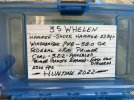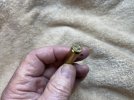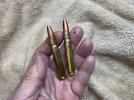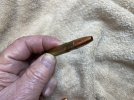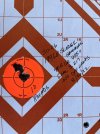Working towards this 25/280AI build. I just order out Hammer 121 & 128 gr bullets for the rifle. Iam going to get Bartlien barrel in a 7 twist rate. I haven't determine the barrel thickness and length. I know it won't be under 26". Probable in a 28" for cut back. About to final on the reamer dimensions.
-
If you are being asked to change your password, and unsure how to do it, follow these instructions. Click here
You are using an out of date browser. It may not display this or other websites correctly.
You should upgrade or use an alternative browser.
You should upgrade or use an alternative browser.
Why Hammer Bullets Are Always Faster
- Thread starter HammerBullets
- Start date
 Help Support Long Range Hunting Forum
Help Support Long Range Hunting Forum
Look forward to your results. Will be interesting to the velocity of those two hammers. I don't have a fast enough twist to try the 128 HH out of my 25-284. It's close but I prefer to over spin them.Working towards this 25/280AI build. I just order out Hammer 121 & 128 gr bullets for the rifle. Iam going to get Bartlien barrel in a 7 twist rate. I haven't determine the barrel thickness and length. I know it won't be under 26". Probable in a 28" for cut back. About to final on the reamer dimensions.
I know what you are talking about. Most of my rifle don't have the twist rate to handle the copper bullets either. I tried Barnes a great many years ago. Found them hard drive and accuracies wasn't what I wanted either.Look forward to your results. Will be interesting to the velocity of those two hammers. I don't have a fast enough twist to try the 128 HH out of my 25-284. It's close but I prefer to over spin them.
Like a used a 308NM forerunner of the 300WM. The WMag is faster than the 308NMag, but not by much. I will post but that going to be a year out or better.
mrdinapoli
Member
- Joined
- Dec 5, 2015
- Messages
- 18
ADDITIONAL THOUGHTS ON HAMMER BULLETS, PRESSURE, AND VELOCITY (3 parts due to figures):
PART 1/3 - DESIGN AND FORM COMPARISON:
For those that have not looked at the Hammer Bullets up close, attached are images and an explanation that may make the differences between the Absolute Hammers, Hunter Hammers, and standard bullets more apparent. When looking at pictures of the bullets sitting on a desk or bench (Fig 1), it is hard to see the subtle difference between the bullets unless you look very carefully and read the description. However, when they are held in the jaws of a set of calipers and backlit, the primary differences become clearly visible. Attached are images of the .277 cal Absolute Hammer 116 gr (Fig 2) and Hammer Hunter 117 gr (Fig 3) bullets, along with a Nosler 130 gr Ballistic Tip (Fig 4), for comparison.
The bearing surface of each Hammer bullet has a parabolic shape, with peaks and valleys in a regular wave form. Each Hammer bullet has the "equivalent" of five separate peaks, which form the driving bands, of full projectile diameter. These are formed by turning the intervening sequences to reduced-diameter valleys. The driving bands have a diameter of exactly 0.2770", and the valleys are turned to just at or just under bore diameter at 0.268". (For context, 27 caliber barrels typically have a bore diameter (distance from the tops of the lands) of 0.270", and a groove diameter of 0.277".)
The tops of the driving bands form the bearing surface that will engage the rifling and seal the bore, while the valleys form essentially the bullets shank and will ride just above the lands providing little or no contact with the bore. Importantly, due to the parabolic design, the bands gently taper upward and the peaks of the bands are very narrow. This is significantly different than most other designs, in which the sequences are wider and flatter. The resulting tapered and narrowed tops of the bands should further reduce engraving pressure and bore friction.
For the Absolute Hammers, the driving bands appear as five distinct raised bands that project above the shank of the bullet, while the ogive and heel taper upward from the bullet ends to approximately the diameter of the central shank (0.268") (Fig 2). For the Hammer Hunters, the ogive and heel of the bullet taper from the ends all the way up to FULL groove diameter, and are the same height as the driving bands, at 0.2770" (Fig 3). For the Hunters, there are three separate driving bands in the center portion of the bearing surface, and the maximum diameter of the ogive and heel make up the fourth and fifth driving bands. For comparison, in the Nosler 130 gr BT, the bearing surface remains at full diameter for the bearing surface's entire length, and the ogive and heel raise up to meet the full diameter (Fig 4).
mrdinapoli
Member
- Joined
- Dec 5, 2015
- Messages
- 18
PART 2/3 - DESIGN IMPACTS ON DTL, PRESSURE, & VELOCITY:
The Hammer Hunters are more similar to traditional bullets than the Absolute Hammers in that the ogive tapers to maximum diameter (0.2770"). This means that the ogive portion of the Hammers will contact the leade (tapered initial portion of the lands) and lands of the rifle barrel first and with a broader surface area compared with first driving band of the Absolutes. From the other accompanying photographs, you can see the difference in initial bullet contact point and depth when the Absolutes (Fig 5) and Hunters (Fig 6) are sitting inside bullet comparators from SAC.
The SAC comparators much more closely approximate a rifle leade than other comparators, as they are cut with a chamber throat-like reamer and have an opening close to bullet diameter that tapers down at 3° (1.5° on each side). Therefore, the contact point and distance that the bullet sits above the bullet comparators is fairly representative of how the bullets will contact the leade and rifling in a barrel. (A gauge pin of 0.277" will just sit at the opening of the comparator, a 0.272" gauge will travel ⅛" into the comparator, and a 0.270" gauge will pass through the comparator.)
Measuring the bullets, the overall length of the Absolute is 1.2020" and the Hunter is 1.2220". However, bullet base to the top of the most forward driving band is consistent at 0.495" each. When placed in the SAC comparators, it can be seen that the Absolute enters further into the comparator before stopping on the forward driving band (just barely seen at the comparator mouth), while the Hunter contacts the comparator at the maximum diameter of the ogive where it essentially forms its most forward driving band. Given that the bullet base to top of the first driving band is the same, the Absolute enters the comparator 0.0735" deeper (0.5335 - 0.4600"). The significance of this is that for cartridges loaded to the same COAL, the DTL (distance to the lands) for the Absolute hunters will be approximately 0.0735" farther than for the Hunter. It is well known and has been shown that as DTL increases (to a point), pressure typically decreases, allowing the use of more of the same or different powders to be used, thus resulting in more velocity at similar pressures. The increased DTL in the Absolutes and the fact that the Hunters have a wider first driving band formed by the ogive, are likely the reasons that the Absolutes have been reported to be able to loaded with more powder and to obtain greater velocities that the Hunters without showing pressure signs.
Any increased DTL with Absolute Hammers or Hammer Hunters compared with standard bullets should also allow them to exhibit lower initial pressures, and thus allow a higher powder charge and higher end velocity at similar pressure levels. Further, when compared to standard bullets, the reduction in total bearing surface area created by the parabolic peaks and valleys in the bearing surface (Fig 1-4, in Part 1/3) should also decrease friction further, thus further reducing pressure and allowing a higher powder charge and higher velocities to be obtained at similar pressure levels.
mrdinapoli
Member
- Joined
- Dec 5, 2015
- Messages
- 18
PART 3/3 - THEORIES AND QUESTIONS FOR REPORTED OBSERVATIONS:
Here are some thoughts, along with some questions for Steve from Hammer Bullets, regarding the discrepancies in theories between powder charges / types, pressure, and velocities for the Hammer-type (mono-core projectile with driving bands) bullets compared to standard cup and core bullets, specifically the comments that Hammer-type bullets can not achieve higher velocities without significant increases in pressure.
From my understanding, the bullet material used to make the Hammer Bullets is similar to the jacket material on cup and core bullets. Therefore, the lubricity and surface hardness should be similar. However, in cross-section, the homogenous copper Hammer Bullets are likely more resistant to deformation and compressive forces compared to the cup and core bullets which have a thin jacket over a much softer lead core. Also, It has also been stated and demonstrated in the literature, that a certain amount of pressure is required to build up for proper powder burn to occur and to build up significant enough pressure to obtain maximum velocity.
Is it possible that when the initial ogive contact of the Hunter bullets or first driving band of the Absolute bullets contacts the leade of the barrel and begins to engrave all the way up to full land height, that this restriction in bore diameter and bullet movement provides enough increase in pressure to allow sufficient powder burn and also to raise pressures high enough to obtain maximum velocity, similar to standard cup and core bullets. However, although the initial ogive contact ring on the Hunters and band on the Absolutes is narrower than the full bearing contact surface on a standard cup and core bullet, the fact that there is less compression of the solid copper cross-section of the hammers compared with the jacket and lead core of the standard bullets provides the additional resistance necessary to reach peak chamber pressures. Thus, at least partially negating the argument that the Hammer bullets do not reach enough initial pressure to obtain reported velocities without excessive pressure.
Assuming the above (that the Hammers can and do reach sufficient pressure once the bands contact the leade and engrave the rifling), once the peak pressures and burn are achieved and the bullet is moving down the barrel, this is where the differences in bullet design likely significantly affect the end results. The driving bands now provide a much lower degree of friction compared to traditional bullets with a full diameter bearing surface. This reduced friction is likely reached for several reasons: 1) The total surface area of the bearing surface is reduced by the fact that there is only contact with the bands, which themselves are significantly reduced due to the parabolic shape; 2) The grooves between the bands provide space for the displaced copper material from the bands to move, also reducing resistance to movement; 3) Cup and core bullets are known to fully obturate to the bore due to the pressure of the expanding gases upon the base of the bullet as well as the bullets resistance to the initial forces of acceleration. Due to the softer lead core, the bullet will deform substantially more than the mono-cores, leading to more complete contact of the lands and grooves for the entire length of the bearing surface, as well as more pressure being exerted on the lands and grooves due to the greater degree of deformation. I have seen pictures of recovered mono-core bullets that show that the driving bands do fully engage the rifling, and that the driving band material will "wipe" back and fill the following groove. However, it appears that the remainder of the bullet does not deform further to fill the gaps between the driving bands of the mono-cores and the bore like is seen in cup and core bullets and cast bullets.
Interesting topic, and I hope this provides food for thought and discussion. I have my Absolute Hammers and Hammer Hunters loaded and ready for a break in the weather and day off. Best wishes. Mike D.
Zen Archery
Well-Known Member
- Joined
- Dec 27, 2012
- Messages
- 1,553
Last two custom builds and new one in February is literally this… Speed up that TR for those long heavy coppers.I'm calling it the twist. Can't wait to get to load dev. With the 90g AB! Speed + twist - Oh My!
Excellent write-up. Thank you!
This should help overall understanding
GL
This should help overall understanding
GL
RockyMtnMT
Official LRH Sponsor
This is great stuff. Thank you for your effort. I know this took a lot of time and effort on your part to do.View attachment 428319
PART 3/3 - THEORIES AND QUESTIONS FOR REPORTED OBSERVATIONS:
Here are some thoughts, along with some questions for Steve from Hammer Bullets, regarding the discrepancies in theories between powder charges / types, pressure, and velocities for the Hammer-type (mono-core projectile with driving bands) bullets compared to standard cup and core bullets, specifically the comments that Hammer-type bullets can not achieve higher velocities without significant increases in pressure.
From my understanding, the bullet material used to make the Hammer Bullets is similar to the jacket material on cup and core bullets. Therefore, the lubricity and surface hardness should be similar. However, in cross-section, the homogenous copper Hammer Bullets are likely more resistant to deformation and compressive forces compared to the cup and core bullets which have a thin jacket over a much softer lead core. Also, It has also been stated and demonstrated in the literature, that a certain amount of pressure is required to build up for proper powder burn to occur and to build up significant enough pressure to obtain maximum velocity.
Is it possible that when the initial ogive contact of the Hunter bullets or first driving band of the Absolute bullets contacts the leade of the barrel and begins to engrave all the way up to full land height, that this restriction in bore diameter and bullet movement provides enough increase in pressure to allow sufficient powder burn and also to raise pressures high enough to obtain maximum velocity, similar to standard cup and core bullets. However, although the initial ogive contact ring on the Hunters and band on the Absolutes is narrower than the full bearing contact surface on a standard cup and core bullet, the fact that there is less compression of the solid copper cross-section of the hammers compared with the jacket and lead core of the standard bullets provides the additional resistance necessary to reach peak chamber pressures. Thus, at least partially negating the argument that the Hammer bullets do not reach enough initial pressure to obtain reported velocities without excessive pressure.
Assuming the above (that the Hammers can and do reach sufficient pressure once the bands contact the leade and engrave the rifling), once the peak pressures and burn are achieved and the bullet is moving down the barrel, this is where the differences in bullet design likely significantly affect the end results. The driving bands now provide a much lower degree of friction compared to traditional bullets with a full diameter bearing surface. This reduced friction is likely reached for several reasons: 1) The total surface area of the bearing surface is reduced by the fact that there is only contact with the bands, which themselves are significantly reduced due to the parabolic shape; 2) The grooves between the bands provide space for the displaced copper material from the bands to move, also reducing resistance to movement; 3) Cup and core bullets are known to fully obturate to the bore due to the pressure of the expanding gases upon the base of the bullet as well as the bullets resistance to the initial forces of acceleration. Due to the softer lead core, the bullet will deform substantially more than the mono-cores, leading to more complete contact of the lands and grooves for the entire length of the bearing surface, as well as more pressure being exerted on the lands and grooves due to the greater degree of deformation. I have seen pictures of recovered mono-core bullets that show that the driving bands do fully engage the rifling, and that the driving band material will "wipe" back and fill the following groove. However, it appears that the remainder of the bullet does not deform further to fill the gaps between the driving bands of the mono-cores and the bore like is seen in cup and core bullets and cast bullets.
Interesting topic, and I hope this provides food for thought and discussion. I have my Absolute Hammers and Hammer Hunters loaded and ready for a break in the weather and day off. Best wishes. Mike D.
When we designed our PDR drive band technology we had one goal in mind. Cure the pressure and accuracy issues that are typical with pure copper bullets. The million dollar question with copper bullets has always been, "How big around do you make them too seal the bore but not create over pressure issues?". Our PDR design allows us to make Hammer Bullets larger than caliber without creating excess pressure in tight bore rifles while still maintaining accuracy in loose bore rifles. The radius design makes the outside diameter so finite that the amount of bearing surface contact becomes unconstitutional from rifle to rifle. By making the bands parabolic in nature the rifling engraves and gets progressively more surface or meat to hold or grip the bullet so they do not slip in the twist. The deeper valleys leave room for material deposit as well as less contact in the barrel. When we designed this we did not know that there would be an across the board increase in accuracy from rifle to rifle. We did not know that Hammer Bullets would be almost intolerant to jump. After the fact I can still only theorize why. I believe it is due to the radius design not varying the the engraving pressure when it is closer or farther from the lands. That along with holding extremely tight dimensional tolerance, they are very consistent. With that we also use the softest copper possible and still keep it in bar form. This does allow some obturation under pressure. This would be the reason that in some rifles we see accuracy increase when the pressure is pushed a bit.
The Absolute Hammers were not initially designed for the extra low engraving pressure and resulting speed. We were trying to come up with a cure for varying bc from rifle to rifle because of tighter bores engraving further onto the ogive causing the bc to decrease. We knew it would greatly decrease the engraving pressure but had no idea it would as much as it does. The design became something different than the original intent.
I have to add. None of this was as important to us as terminal performance. A hunting bullet must consistently perform at a wide range of impact velocities and shot angles that are not as perfect as we think they are in the heat of the moment. The largest, longest permanent wound channel is and always will be the most important aspect of Hammer Bullets. We will not sacrifice terminal performance for anything. The hunt always comes down to the bullet performance. All the planning, gear, and effort comes down to the bullet performance on impact.
What hammers and powders was you using in your 35 Whelen? What kind of groups were you getting? Think of trying these in the near future.
Here are some photos of 35 Whelen 223gr Shock Hammers assembled and a photo of the load data that I used "For my rifle". This particular load is somewhat mild in my rifle; however...there are no issues and the shoot cloverleafs. I cannot stress enough that these Hammer bullets are a different animal. It is "very" important that you make all of the necessary measurements that ought to be taken when reloading, and...always start low and work your way up with powder weights. I loaded these Hammers to use on a black bear hunt, only to find that the bolt closed ever so tightly, too tightly for my liking. I really was a bit rushed because I ordered them a bit late and got them in at the last minute. I reloaded everything as I would a Barnes TSX bullet, same load data and same COAL. I always go to the range before taking any ammunition on a hunt; however...because I was rushed a bit this didn't happen. I figured (WRONG) that all would be fine and that I would check the rounds out at the camp when we got there. Well....that wasn't such a good plan. At the camp we zeroed our rifles in, and it was at this time that I noticed the bolt was closing a bit too tightly for my liking with a hunting round. Then upon firing I found signs of pressure, and...again the bolt was opening a bit tight. So....I didn't use the Hammers for this hunt. At home I pulled all of these loads and started from scratch. I had the same issue with some 199gr Sledge Hammers in 30-06. What I found was the ogive was different from any other bullet I have used, COAL had to be changed quite a bit. But....I did some measurements and found that for the first time the ogive of the bullet was hitting the lands. From there I seated the bullet to .020 thousandths off the lands, found these to be very accurate in my rifle. I tried loading some 221gr Hammer Bushmasters for my son's custom built, match AR. This was my first experience with Hammer bullets. I started at a load that I "thought" was low; however...it was not low enough and after a few shots the rifle blew a primer. I believe that a tight, custom match barrel and the extra .0002 tenths on the Hammer bullets created the pressure curve. It has been my experience that there is nothing wrong with the Hammer bullets, it is that one cannot cut any corners with these bullets, because if you do (as I did) cut corners you will in all likelihood run into issues; they are a different bullet. One last thing that I do is to use a Lee Factory Crimp die on every cartridge that I load Hammers in. The LFCD affords the ability to put the crimp wherever it needs to be without having to worry about where the mouth of the case hits the bullet in relationship with the grooves in the Hammer bullet. Hope this helps you out.
Attachments
A lot of work in putting this together above. Thanks! In the reading, and not being engineer, stated what I felt. I know that the Barners bullet I tried a great many years ago. They were hard to push, and the accuracies wasn't there for me. So I never got passed the bench with them.
Thank you for the advice!!Here are some photos of 35 Whelen 223gr Shock Hammers assembled and a photo of the load data that I used "For my rifle". This particular load is somewhat mild in my rifle; however...there are no issues and the shoot cloverleafs. I cannot stress enough that these Hammer bullets are a different animal. It is "very" important that you make all of the necessary measurements that ought to be taken when reloading, and...always start low and work your way up with powder weights. I loaded these Hammers to use on a black bear hunt, only to find that the bolt closed ever so tightly, too tightly for my liking. I really was a bit rushed because I ordered them a bit late and got them in at the last minute. I reloaded everything as I would a Barnes TSX bullet, same load data and same COAL. I always go to the range before taking any ammunition on a hunt; however...because I was rushed a bit this didn't happen. I figured (WRONG) that all would be fine and that I would check the rounds out at the camp when we got there. Well....that wasn't such a good plan. At the camp we zeroed our rifles in, and it was at this time that I noticed the bolt was closing a bit too tightly for my liking with a hunting round. Then upon firing I found signs of pressure, and...again the bolt was opening a bit tight. So....I didn't use the Hammers for this hunt. At home I pulled all of these loads and started from scratch. I had the same issue with some 199gr Sledge Hammers in 30-06. What I found was the ogive was different from any other bullet I have used, COAL had to be changed quite a bit. But....I did some measurements and found that for the first time the ogive of the bullet was hitting the lands. From there I seated the bullet to .020 thousandths off the lands, found these to be very accurate in my rifle. I tried loading some 221gr Hammer Bushmasters for my son's custom built, match AR. This was my first experience with Hammer bullets. I started at a load that I "thought" was low; however...it was not low enough and after a few shots the rifle blew a primer. I believe that a tight, custom match barrel and the extra .0002 tenths on the Hammer bullets created the pressure curve. It has been my experience that there is nothing wrong with the Hammer bullets, it is that one cannot cut any corners with these bullets, because if you do (as I did) cut corners you will in all likelihood run into issues; they are a different bullet. One last thing that I do is to use a Lee Factory Crimp die on every cartridge that I load Hammers in. The LFCD affords the ability to put the crimp wherever it needs to be without having to worry about where the mouth of the case hits the bullet in relationship with the grooves in the Hammer bullet. Hope this helps you out.
Mrdinapoli,
Please post your excellent write-up on the Hammertime Forum. Many would benefit from your knowledge and explanation.
Thank ypu so much.
Please post your excellent write-up on the Hammertime Forum. Many would benefit from your knowledge and explanation.
Thank ypu so much.
mrdinapoli
Member
- Joined
- Dec 5, 2015
- Messages
- 18
Steve, Thank you for the information and discussion. The history and your findings along the way are very interesting. Thank you for your willingness and openess in discussing your bullets. We all appreciate it and can learn a lot. Best wishes. Mike DThis is great stuff. Thank you for your effort. I know this took a lot of time and effort on your part to do.
When we designed our PDR drive band technology we had one goal in mind. Cure the pressure and accuracy issues that are typical with pure copper bullets. The million dollar question with copper bullets has always been, "How big around do you make them too seal the bore but not create over pressure issues?". Our PDR design allows us to make Hammer Bullets larger than caliber without creating excess pressure in tight bore rifles while still maintaining accuracy in loose bore rifles. The radius design makes the outside diameter so finite that the amount of bearing surface contact becomes unconstitutional from rifle to rifle. By making the bands parabolic in nature the rifling engraves and gets progressively more surface or meat to hold or grip the bullet so they do not slip in the twist. The deeper valleys leave room for material deposit as well as less contact in the barrel. When we designed this we did not know that there would be an across the board increase in accuracy from rifle to rifle. We did not know that Hammer Bullets would be almost intolerant to jump. After the fact I can still only theorize why. I believe it is due to the radius design not varying the the engraving pressure when it is closer or farther from the lands. That along with holding extremely tight dimensional tolerance, they are very consistent. With that we also use the softest copper possible and still keep it in bar form. This does allow some obturation under pressure. This would be the reason that in some rifles we see accuracy increase when the pressure is pushed a bit.
The Absolute Hammers were not initially designed for the extra low engraving pressure and resulting speed. We were trying to come up with a cure for varying bc from rifle to rifle because of tighter bores engraving further onto the ogive causing the bc to decrease. We knew it would greatly decrease the engraving pressure but had no idea it would as much as it does. The design became something different than the original intent.
I have to add. None of this was as important to us as terminal performance. A hunting bullet must consistently perform at a wide range of impact velocities and shot angles that are not as perfect as we think they are in the heat of the moment. The largest, longest permanent wound channel is and always will be the most important aspect of Hammer Bullets. We will not sacrifice terminal performance for anything. The hunt always comes down to the bullet performance. All the planning, gear, and effort comes down to the bullet performance on impact.
